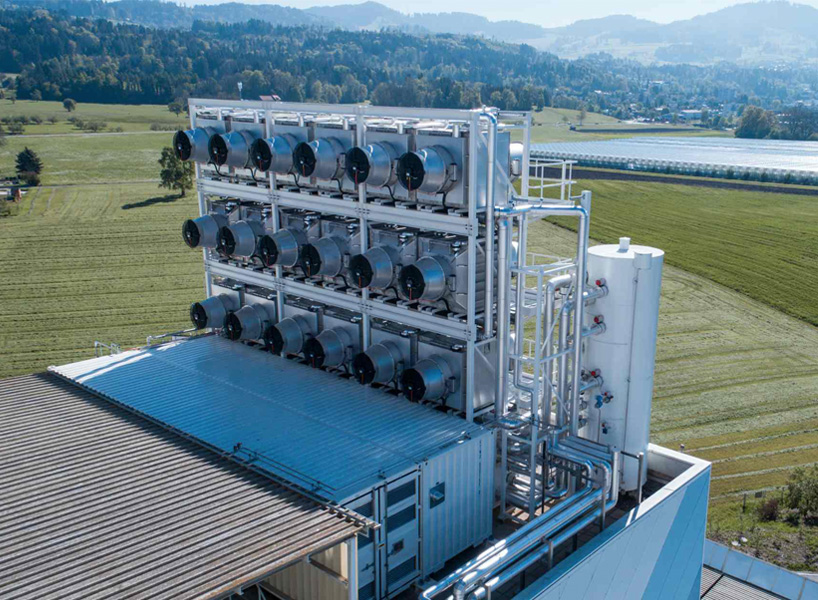
In February, the European Commission published its highly anticipated industrial carbon management strategy. The document outlines the Commission’s plans to build an EU-wide carbon management infrastructure as part of its efforts to decarbonize the industrial sector and achieve negative emissions. This blog post discusses these plans by (i) looking at the underlying challenges, (ii) reviewing the scope of the strategy, (iii) analyzing the current regulations, and (iv) assessing the proposed measures to spur the development of carbon management infrastructure within the EU.
Decarbonizing industry and the importance of negative emissions
The EU has set ambitious climate targets, aiming to reduce its emissions by at least 55% below 1990 levels by 2030, reach net-zero by 2050 and generate net-negative emissions thereafter. In addition, just last month the Commission proposed an interim target of a 90% reduction in emissions by 2040 compared to 1990 levels.
Decarbonizing the industrial sector is key to achieving these targets, as it is responsible for around 20% of the EU’s total emissions (not including emissions associated with energy consumption by industry). However, unlike the energy sector, where renewable energy sources, reduced consumption and increased energy efficiency offer clear alternatives to today’s heavy reliance on fossil fuels, decarbonizing the industrial sector presents a more complex challenge. While the above measures will also play a role in reducing industrial emissions, there remain several processes, particularly in cement, steel and chemical production, for which low-carbon substitutes are not yet readily available. Specific technological solutions are therefore needed to reduce these process emissions.
Furthermore, despite all efforts to decarbonize, some residual emissions are expected not only from industrial activities but also from other “hard-to-abate” sectors such as agriculture, aviation, and transport. In fact, the impact assessment supporting the Commission’s proposed 2040 target suggests that the EU may need to remove up to 400 million tons of carbon dioxide (CO2) from the atmosphere annually by 2040, and significantly more to achieve net-negative emissions after 2050. While natural carbon sinks such as trees and oceans will account for a large proportion of the required carbon removals, additional technological solutions will also be needed.
Scope of the European Commission’s Carbon Management Strategy
The Commission’s industrial carbon management strategy responds to these challenges and outlines its plan to tackle hard-to-abate emissions with the help of three different carbon management technologies:
- Carbon Capture and Storage (CCS): CCS is a technology that captures CO2 emissions typically directly from combustion or industrial processes, and permanently stores them in geological formations, thereby reducing the quantity of additional emissions released into the atmosphere.
- Carbon Dioxide Removal (CDR): CDR is an umbrella term for technologies that remove and store CO2 from the atmosphere. In terms of CDR, the Commission focuses on two specific technologies: Direct Air Carbon Capture and Storage (DACCS) and Bioenergy with Carbon Capture and Storage (BECCS). In DACCS, CO2 is filtered directly from the atmosphere before it is transported and injected into geological formations for permanent storage. In BECCS, biomass is used to produce energy, and the emissions from its combustion are then captured, transported, and permanently stored underground. The rationale is that prior to its combustion, biomass removes CO2 from the atmosphere through photosynthesis. Thus, over the entire lifecycle of the BECCS process, a negative emission balance remains. Both BECCS and DACCS can achieve permanent carbon removals. However, they are energy-intensive and, in the case of BECCS, resource-intensive processes, and the production of the required energy releases additional CO2 emissions as long as the energy mix in the EU relies significantly on fossil fuels. Thus, the net effect of BECCS and DACCS on atmospheric CO2 levels is directly linked to the decarbonization of the energy sector and requires a life-cycle assessment.
- Carbon Capture and Usage (CCU): CCU refers to a range of technologies that capture CO2 and then recycle it to produce synthetic fuels, chemicals, or other products. Because use of the products typically releases the CO2 back into the atmosphere after a limited period of time, CCU cannot permanently prevent additional emissions, nor can it permanently sequester CO2 from the atmosphere. However, because CO2 is regularly needed as a feedstock, CCU could be part of a circular carbon economy if it uses CO2 that has been removed from the atmosphere.
While CCS, CDR (DACCS and BECCS) and CCU serve different purposes and carry different risks, there are significant synergies allowing them to profit from a shared carbon infrastructure. The common starting point for these technologies is the capture of CO2, albeit from different sources (e.g., from industrial processes in CCS, directly from the atmosphere in DACCS, or from biomass combustion in BECCS). If the source of CO2 and the storage site or recycling facility are not located in close proximity (e.g. in carbon management clusters or hubs), all three pathways require a CO2 transport infrastructure. As a critical final step, the CO2 is either permanently stored in a suitable geological storage site or reused within a respective facility. Drawing on these synergies, the Commission envisions establishing an EU-wide carbon infrastructure accessible to all three carbon management pathways. This infrastructure is expected to enable a single market for carbon management within the EU and facilitate the achievement of the EU’s climate targets by aligning supply and demand for carbon management across Member States.
The scale of the proposed undertaking is huge. In its strategy, the European Commission predicts that at least 50 million tons of CO2 will need to be captured annually in the EU in 2030 to meet its climate targets, rising to 280 million tons in 2040 and 450 million tons in 2050. While in 2030 80% of the captured CO2 is expected to come from industrial processes and another 10% directly from fossil fuel combustion, by 2050 more than 60% of the captured CO2 is expected to come either from biomass or directly from the atmosphere, resulting in negative emissions.
To put this in perspective, the EU would need to capture more than Sweden’s total annual emissions (about 40 million tons of CO2 in 2023) every year by 2030 and more than ten times that amount by 2050. In terms of further processing, it is estimated that by 2030 almost all of the captured CO2 will be geologically stored, but the strategy foresees that CCU will be phased in by 2040 and will account for almost 50% of the captured CO2 by 2050.
Given the fact that many of the technologies that these projections are based on have not yet been deployed on a commercial scale and some of them are associated with significant environmental risks, these targets are highly ambitious and substantial regulatory and financial support will likely be required to achieve them.
Current state of carbon management in the EU
The challenge ahead becomes all the clearer when one considers the current state of carbon management within the EU. While the EU has been promoting the development of a CCS infrastructure for more than a decade, its efforts have yielded relatively few results so far.
Back in April 2009, the EU adopted the CCS-Directive, a legal framework for the regulation of CCS by Member States that aims to achieve the environmentally safe storage of CO2 through siting, permitting, monitoring and liability requirements for storage sites. While emissions from industrial processes fall within the scope of the CCS-Directive, it was originally targeted at the energy sector, introducing CCS as a solution to reduce emissions from fossil-fueled power plants. The main incentive for CCS is provided by the European Emissions Trading Scheme (EU-ETS), which was amended in 2009 to exempt industrial facilities and power plants from the obligation to purchase emission allowances if they capture CO2 for storage in accordance with the CCS-Directive. At the same time, entities involved in the CCS process – whether in the capture, transport, or storage of CO2 – are required to purchase allowances if CO2 leakage occurs within their sphere of responsibility.
Although the CCS-Directive has been in place for almost fifteen years and the EU has since created several additional funding opportunities for CCS, only few Member States (Denmark, the Netherlands and Greece, plus Norway as a member of the European Economic Area) have so far moved to issue permits for CO2 storage sites or exploration thereof on their territory. While some of the remaining Member States simply don’t have suitable storage sites, even some of those who do have been reluctant to allow storage due to environmental concerns, strong opposition from local communities and NGOs, as well as limited ambition on climate action and low carbon prices under the EU-ETS.
Compared to CCS, both CDR and CCU are newer additions to EU climate policy and key elements of the regulatory framework have yet to be put in place. While the geological storage provisions of the CCS Directive may apply to CDR, both direct air capture and transport of CO2 are only partially regulated by the EU. In addition, industrial carbon removals currently don’t fall within the scope of either of the three main pillars of the EU’s climate policy framework: (1) the EU-ETS Directive, (2) the Effort-Sharing Regulation, and (3) the Land, Land Use Change and Forestry Regulations. As a result, they lack a clear pathway to integration into the EU’s broader climate policy. Regarding CCU, only some uses of captured CO2 are currently supported by legislation, notably the use of CO2-based fuels in the transport sector. However, a comprehensive regulatory framework that tracks the source, transport, and use of CO2 in different CCU activities and ensures environmental integrity and addresses liability in case of leakage does not yet exist.
In addition to these regulatory challenges, both CDR and CCU activities are also hampered by a lack of financial support. Most importantly, since the EU-ETS does not account for carbon removals, they are not incentivized by the carbon market price. This is particularly problematic for DACCS, which is highly energy and therefore cost intensive and is likely to require substantial financial support. In terms of CCU, the EU-ETS was amended in May 2023 to exempt CCU activities from the obligation to purchase emission allowances if the storage of CO2 in products can be considered permanent. However, the conditions under which this requirement is met are yet to be specified by the Commission and as most CCU applications retain CO2 only for a short period of time the scope of the amendment is limited.
Due to the incomplete regulatory framework, as well as the lack of suitable storage sites and financial incentives for both storage and usage of CO2, the necessary capture and transport infrastructure has also been slow to develop so far.
Proposed policy measures to spur Carbon Management in the EU
The carbon management strategy outlines several policy measures currently underway or in the pipeline to address these bottlenecks and accelerate the development of CCS, CCU and CDR.
The most comprehensive is the proposed Net Zero Industry Act (NZIA). The NZIA was adopted by the Commission in spring 2023 and substantially amended by European Parliament and Council delegates in the informal trilogue process earlier this year. Following its formal adoption by the Parliament two weeks ago, it is now expected to be formally adopted by the Council by the end of May and enter into force shortly thereafter.
The NZIA requires Member States to recognize a range of technologies, including CO2 storage, as strategic net-zero projects, resulting in expedited review, special/overriding consideration in the approval process, and financial support measures. Specifically, the NZIA requires Member States to designate a single point of contact for permit applicants, to ensure that these projects are treated in the most expeditious manner possible under national law, and to limit the duration of the permitting process to 18 months after receipt of all necessary documentation. As a result, applicants for a CO2 storage site permit, who might otherwise have to seek permits from several different agencies, will be able to communicate with only one designated point of contact and expect a final decision in less than two years. In addition, the NZIA provides that Member States shall consider strategic net-zero projects (such as CO2 storage sites) to be in the public interest and may declare them to be of overriding public interest. The special importance of these strategic net-zero projects in serving the public interest thus must be taken into account in all government decisions, particularly in permitting and planning decisions, that require the balancing of different interests.
The NZIA also sets an EU-wide minimum annual storage capacity target of 50 million tons of CO2 by 2030 and requires companies with permits to extract oil and gas in the EU to contribute to this annual storage capacity either by investing in storage projects or by developing storage projects themselves. In doing so, the NZIA leverages the technological know-how, specific knowledge of the suitability of depleted oil and gas fields for CO2 storage, as well as the financial resources of the oil and gas industry.
Regarding CDR and some CCU technologies using CO2 removed from the atmosphere, a few weeks ago the Parliament formally adopted a provisional agreement with the Council on a certification framework for voluntary carbon removals (CFCR). The framework, which is expected to be adopted by the Council in the coming weeks and enter into force shortly thereafter, sets out rules for quantifying, monitoring and reporting the climate benefits of carbon removals. Under the CFCR, an applicant for certification must be able to quantify its carbon removals (“quantification”), demonstrate that these removals would not have occurred in the absence of the activity (“additionality”), ideally be long-term, and address sustainability concerns. These so-called “Qu.A.L.ITY” criteria are intended to ensure the integrity of a CDR activity and are assessed by certification bodies accredited by the Commission. Once certified, CDR activities can be registered as units (measured in tons of CO2 removed) in a future EU registry and will be subject to monitoring requirements. The units can then be used as part of the EU’s Nationally Determined Contribution (NDC) under the 2015 Paris Agreement. Furthermore, they are expected to be integrated into other EU climate policies, such as the EU-ETS, and accelerate investment in CDR activities within the voluntary carbon market.
In addition to these regulations, the Commission’s carbon management strategy includes several more limited policy measures, such as the creation of an atlas providing information on available storage sites in the EU and the development of step-by-step guidelines for permitting storage sites. It further announces that the Commission will start work on a “policy package” on CO2 pipeline infrastructure within this year and present its proposals for the inclusion of carbon removals in the EU-ETS in 2026.
Remaining uncertainties and inconsistencies
While the previously discussed regulations and policies represent important steps forward, some significant inconsistencies and uncertainties regarding their scope and impact remain. For one, during the legislative process of the NZIA, the source of CO2 eligible for storage was debated. Although the Commission’s carbon management strategy foresees that only 10% of the CO2 stored in 2030 will come directly from fossil fuel combustion (e.g. oil in the transport sector or gas for heating) and 80% from industrial process emissions, the proposed NZIA, as well as the EU-ETS and CCS-Directive, provide the same regulations and incentives to use CCS in industrial processes as in the energy sector. Thus, these policies not only allow, but through the NZIA also incentivize, the deployment of CCS in gas- and coal-fired power plants through procedural and financial support measures. While using CCS in the energy sector may appear beneficial for the climate in the short term, providing incentives to delay the phase-out of fossil fuels not only risks fossil lock-in, but also seems inconsistent with the Commission’s own projections. Recognizing this, the European Committee of the Regions, which represents local and regional voices in the legislative process, proposed amendments to the NZIA that would have limited storage capacity to “unavoidable” emissions (referring to emissions from industrial processes that are currently lacking low-carbon alternatives) and introduced a requirement for “additionality” of emission reductions achieved through CCS. However, these amendments did not make it into the consolidated version of the text. Thus, given the environmental risks of geological carbon storage and the importance of phasing out fossil fuels, the scope of the regulations remains questionable.
With respect to CDR as well as CCU, ongoing monitoring and reporting, as well as effective liability regimes, are critical to achieving long-term, reliable climate benefits. While the CFCR provides a basic structure, it is purely voluntary, and the individual monitoring, accounting, and reporting rules for different removal techniques, as well as a liability mechanism in case CO2 is (prematurely) released back into the atmosphere, are yet to be designed and adopted by the Commission. The actual impact and coherence of the regulation therefore depend largely on delegated acts by the European Commission and further regulations that have yet to be fleshed out. In addition, both the scope and timing of the integration of the CRFC into other climate policies are still unclear. As a result, questions remain about the role of these technologies in the EU’s broader climate policy, as well as the financial support needed to make these technologies economically viable.
Conclusion
The Commission’s industrial carbon management strategy rightly emphasizes the need for CCS, CDR and CCU to address emissions from industry and other hard-to-abate sectors. However, the scale of work required to implement the strategy is enormous, especially as many Member States have only recently included carbon management technologies in their National Energy and Climate Plans and some of the technologies have yet to be deployed on a commercial scale.
In addition, given the significant environmental risks of some technologies, the proposed regulations and policies fall short in setting limits on their use and leave important questions about accounting, monitoring and reporting of their climate benefits unanswered. Further regulatory and policy reforms will therefore be needed if the strategy is to be successful.

Lena Kannenberg
Lena Kannenberg is a doctoral candidate and researcher in administrative and constitutional law at the Ludwig-Maximilians-Universität in Munich. She is a fellow of the German Academic Scholarship Foundation and a visiting scholar at Columbia Law School.




